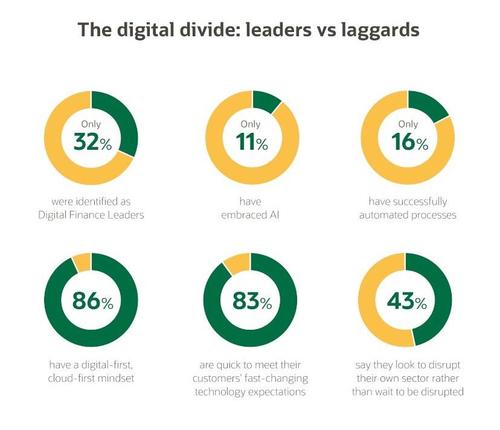 By Angela Mazza Teufer
By Angela Mazza Teufer
Senior Vice President ERPM WE, ERPM North install base
Finance has always taken advantage of technology to improve productivity and collaboration. But with continuous innovation now driving our economy, the goalposts have moved. Today’s organizations must adopt an agile finance operating model– powered by emerging digital technologies and skillsets. The success of that model depends on 5 keys traits that the Finance Team must possess.
When Oracle and the Association of International Certified Professional Accountants (AICPA) decided to follow up our look at the best finance organizations, we already knew that agile finance functions were taking advantage of cloud technologies to improve efficiency; centralize process management and subject matter expertise; make greater use of analytics to contribute insights; and deploy multi-disciplinary teams to partner with decision makers.
Talking to both agile finance pioneers and those in less-advanced organizations for the new report, Agile Finance Unleashed, we discovered even deeper links between successful business and digital finance transformation. And the conversations with CFOs successfully delivering operational excellence and strategic influence using digital intelligence led to five conclusions about what makes for effective, future-ready finance leaders.
They take a customer-first, holistic approach to organizational change
Rather than focus on optimizing or improving standalone business processes, look at optimizing the end-to-end customer and employee experiences, based on the customer value they will create.
One of the starkest differences between leaders and laggards in the Agile Finance Unleashed report was around customers: 83% of Digital Finance Leaders say their organization is quick to meet customers’ fast-changing technology expectations, but this drops to 28% for the non-leaders. Empowerment is critical. The end-state of any transformation should be a workforce that instinctively prioritizes customer experience; and has the tools to deliver that experience using solutions from across the whole organization.
This isn’t just about FMCG brands or technology services. Take Kansas City Power & Light. The utility business model is simple, but faced with regulatory evolution and raised customer expectations, it realized it needed to change. Building an integrated customer information system (CIS) allowed the teams there to take a holistic view of each of its 830,000 customers and refine its approach to problem solving, customer support – where teams had previously had to wrestle with more than 20 disparate systems – and efficiency.
They focus on platforms, not products
In today’s economy, it’s no longer about products, but experiences and digital ecosystems that bring users and providers together to create shared value.
It’s no coincidence that the world’s most valuable companies right now are built around platforms. Apple, for example, established itself through products. But the journey from Mac to iPod to iPhone was really about the development of a customer-oriented ecosystem – a platform that allows the company to sell additional services and complementary products and services.
Platforms are a natural extension of a customer-focused approach to change. It’s about optimizing the wider experience, not securing a one-time transaction. For agile finance leaders, that means understanding and analyzing the true value of customers; and being able to spot and evaluate M&A opportunities in complementary business areas for the customer.
They use data as a strategic asset
Digital leaders place an economic value on data and look to monetize it, versus just managing it.
Silicon Valley VC Mary Meeker summed up this priority in her 2019 Internet Trends Report.
At the starts of the web era, she says, winning businesses used digital data and insights – not just what they knew about people – to improve customer experiences. Over the past 15 years, winning businesses realized they must use ‘data plumbing tools’ to collect, manage and optimize data to the same end.
Agile finance requires that the first two are done better – faster, more cheaply and more thoroughly. But optimizing the use of data and finding insights from the fire hydrant of outputs is now a must. And for true future-ready finance leaders, that also means looking outside the traditional skill-sets in their teams – from awareness of new technologies, to skills in data science and advanced analytics. Worryingly, in the Agile Finance Unleashed report, only one in ten CFOs said their “finance team has the skills it needs to support the organization’s digital ambitions.”
They foster a change-ready culture
Adopt an agile approach to change that is iterative, empirical, and continuously improving. Businesses that are highly motivated to change and experiment are the ones that see the greatest success.
That’s true even in very traditional, highly ‘physical’ businesses where capital-intensive investment in fixed assets has long been the key differentiator. DP World, for example, is the world’s fourth largest ports operator – not an obvious type of business that would need to embrace agility. But for CEO Sultan Ahmed bin Sulayem, investment to facilitate digital transformation is critical.
“Employing cloud applications that can increase efficiency, create new services and support diversification will add value for all our stakeholders and aid our vision to become a digitized global trade enabler,” he says. “In this dynamic digital age, it’s essential that we keep up with our customers’ growing needs. As global trade becomes increasingly digitalized, our stakeholders also require agile tech infrastructure that can integrate quickly and seamlessly.”
They secure a top-down, executive mandate
To radically change your culture, you need more than just management buy-in; you need an executive mandate to adopt a customer-first approach to business that permeates every organizational function.
Legacy systems and processes stymie change. Future-ready finance is all about delivering a 360-degree view of the organization, but that’s impossible when data is locked in silos, information flows slowly and teams can’t collaborate. The Agile Finance Unleashed report revealed that 37% of CFOs spend more time collecting data than analyzing it, with 59% of large organizations saying that “difficulty extracting data from legacy platforms” is a major challenge.”
This cannot change if a team or business unit decides to undertake a transformation project in isolation. That’s one reason why it’s so important that executive leadership doesn’t just support whole-organization digital transformation – it must evangelize it. True commitment to customer-oriented change needs to be driven from the very top – the CEO, but especially the CFO who is usually in the best position to see how the transformation ripples through the business and can both set its objectives and measure its effects.
A Digital Finance Leader is one who deploys an agile model that can meet the continuous need for innovation in their organization – and is able to build and support the platforms essential to guide strategic decisions using insightful analysis based on reliable, 360-degree data on customers.



























